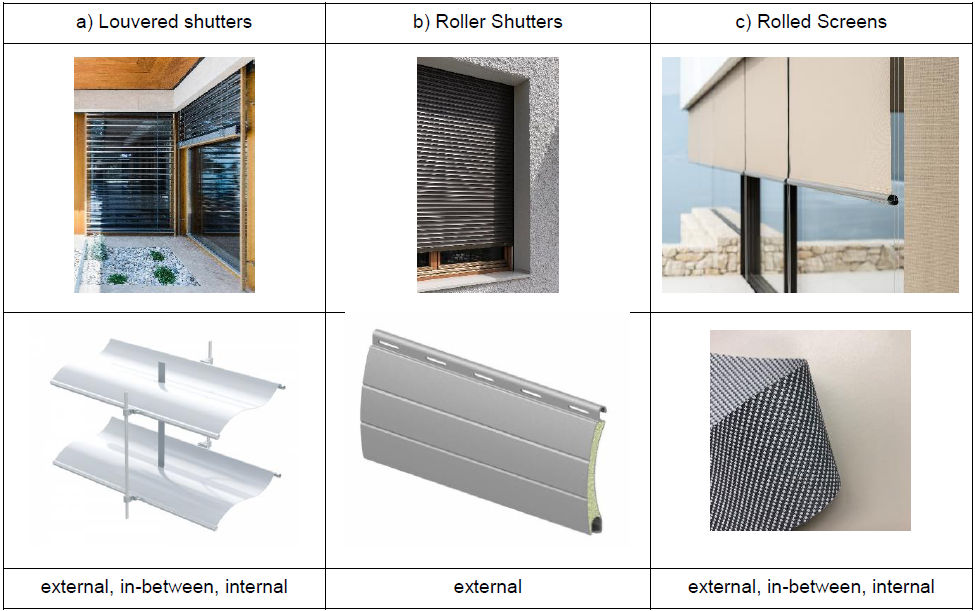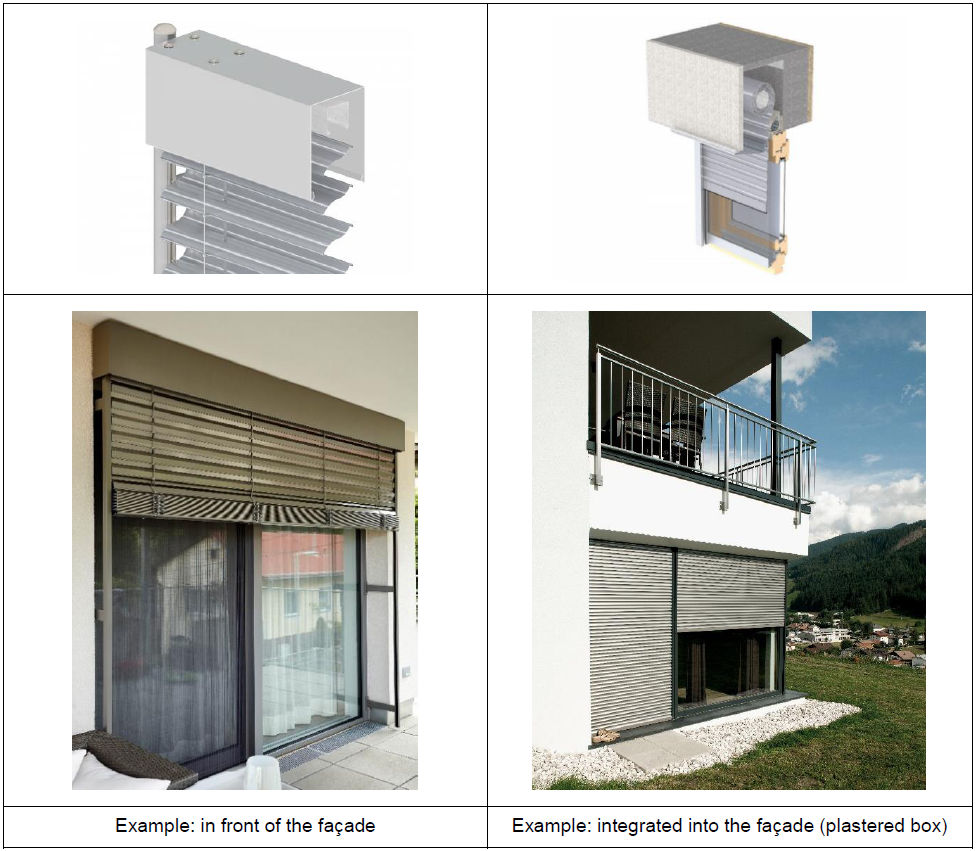Solar Gains Control Systems
Commercial Systems
Venetian Blinds, Roller Shutters and Textile Screens
By Carolin Hubschneider, Fraunhofer IBP, Germany and Robert Weitlaner, HELLA Sonnen- und Wetterschutztechnik GmbH, Austria
Product Description
Brief Concept Description
Common devices used for daylight management and solar shading are:
- Venetian blinds (also known as louvered shutters): they consist of multiple horizontal or vertical slats, which can be fixed or movable. The cross section of slats can have different shapes, such as C-shape, Z-shape or S-shape. The surfaces are in general mostly diffuse with specular reflection gloss of 30 to 80 GU but specular, micro-facetted or retroreflective surfaces are also available (for in-between or internal use only).
- Roller shutters: they are curtains made of many horizontal profiled bars, mostly made of aluminium, plastic or wood, hinged together. Roller shutters can be raised to open and can be closed tightly for solar protection and darkening purposes. To widen the possibilities of daylight control, the use of translucent / transparent hinge-connectors and the integration of translucent bars and bars with movable slats is also possible.
- Textile screens: they consist of a movable screen called rolled screen if a fabrique is flat and pleated/ cellular shade if the fabrique is pleated. The textile has different light transmission according to colour and the material of the fabric. Common materials are acryls, polyesters or PVC-coated glass-fibres or polyesters. In general, a clearer view to the exterior is obtained with smoother surface of the yarn and edges of the openings of the fabrique.
Such shading devices are used to control the incident solar radiation, protect against glare, distribute daylight into the room and also reduce heat losses. Their performance in these tasks depends on many factors including type of device, optical characteristics, material, installation and also mounting position.

Figure 56-2.
Architectural and Technological Integration into the Envelope
These devices can effectively control solar gains when they are installed on the exterior of the façade, as they can significantly reduce direct solar radiation transmission and secondary heat transfer, limiting the risk of overheating of the building (lower g value of the complex fenestration system: window + device). In this case, however, their limited resistance to wind is an issue in medium/high buildings. Additional guiding elements (guide rails or guide cables increase the wind stability. Placed in the interior of the building, these shading devices can achieve good daylight control, but they do not significantly contribute to the reduction of the solar gains. In some cases, as for daylight redirection louvers made of specular material, the device is installed in-between the glass panes and is protected from dust and wind loads.
Venetian blinds, louvred shutters and textile screens can be installed a) in front of the façade or b) integrated into it (plastered box), as shown in the table below.

Figure 56-3.
Integration into the Building: System and Comfort
A significant improvement of the performances is achieved when shading devices are automated. If the manipulation of the device is let to the user, the frequency of manipulation (e.g. rate of change) can drastically lower: in a field study on office buildings (Blindswitch 2017), it was found that only 6,2% of the blinds was operated at least once throughout the day. The implementation of automatic controls allows instead self-adjusting operation base on, for example, climatic conditions or presence of occupants. The coupling with environmental sensors (e.g. photo-sensors, temperature sensors and presence sensors) is however required for automation, so that an improved control of daylight and visual comfort as well as a smart management solar heat gains can be achieved. This additional investment in environmental sensors could be potentially exploited for other advanced controls, such as thermostats regulation or artificial lighting use.
SWOT Analysis
Strengths
- The visual comfort is enhanced because of glare reduction and a view to the exterior is still possible, depending on the device
- The availability of daylight in room depth is high for louvered shutters and some types of roller shutters
- It is possible to control the solar heat gains (external devices better than internal ones) and reduce the risk of overheating in summer
- Movable systems can be easily adapted depending on occupancy and climate condition (louvers more flexible than other devices)
- Internal devices have lower costs than all others
- In-between devices are protected from wind and dust
- Roller shutters are good in obscuring and fabriques inserted in special guide rails are able to black out (ZIP technology)
Weaknesses
- External devices are susceptible to wind loads (roller shutters less than louvered shutters) and produce vibrations and noise under wind conditions
- External devices influence and define the architectural appearance of the façade
- External devices reduce solar heat gains also when they are welcome (winter), whereas internal devices are poor in controlling solar heat gains during the cooling season
- Daylight redirection features suffer from dust deposition and maintenance is necessary
- In-between devices are sometimes difficult to maintain as the glass compound is not openable
- Roller shutters made of PVC are prone to softening caused by high temperatures
Opportunity
- The most efficient solution in terms of solar heat gain control and adaptability (external louvered shutters) is well established in Europe, but still quite unknown elsewhere
- Suitable for new constructions and retrofit projects (internal devices are less invasive)
- The functionality of the system can be enhanced by adding more technology to the slats (e.g. PV) or creating advanced, holistic control systems
- The technology is mature: highly available with many manufacturers
Threats
- External devices cannot be combined with currently popular all-glass facades
- Electrochromic glasses are challenging the today’s available devices (no wind, no dust, no maintenance susceptible) – but among other things these glasses cannot redistribute daylight to room depth compared to louvered shutters
- The integration into the façade needs space that could be used for other features in multifunctional envelope solutions
Lessons Learned
- Louvered shutters are the most popular sun protection system in central Europe with a 2/3rd market share as they offer – if operated properly – high flexibility in the trade-off between daylight supply, glare control, view out and solar protection.
- Louvered shutters are available in many design and technical variations. This encompasses among others different slat designs and control schemes including energy efficient light redirection functionalities. Due to the big market share, they are often more economic than other shading solutions of comparable performance.
- Roller shutters made of PVC are the cheapest solution for an external device.
- In-between louvered shutters or fabriques are an appropriate solution for high wind exposures and are performing well in all requirements.
- Internal devices are performing poor but are cheap as the materials do not need to be outdoor proven (UV stability, etc.).